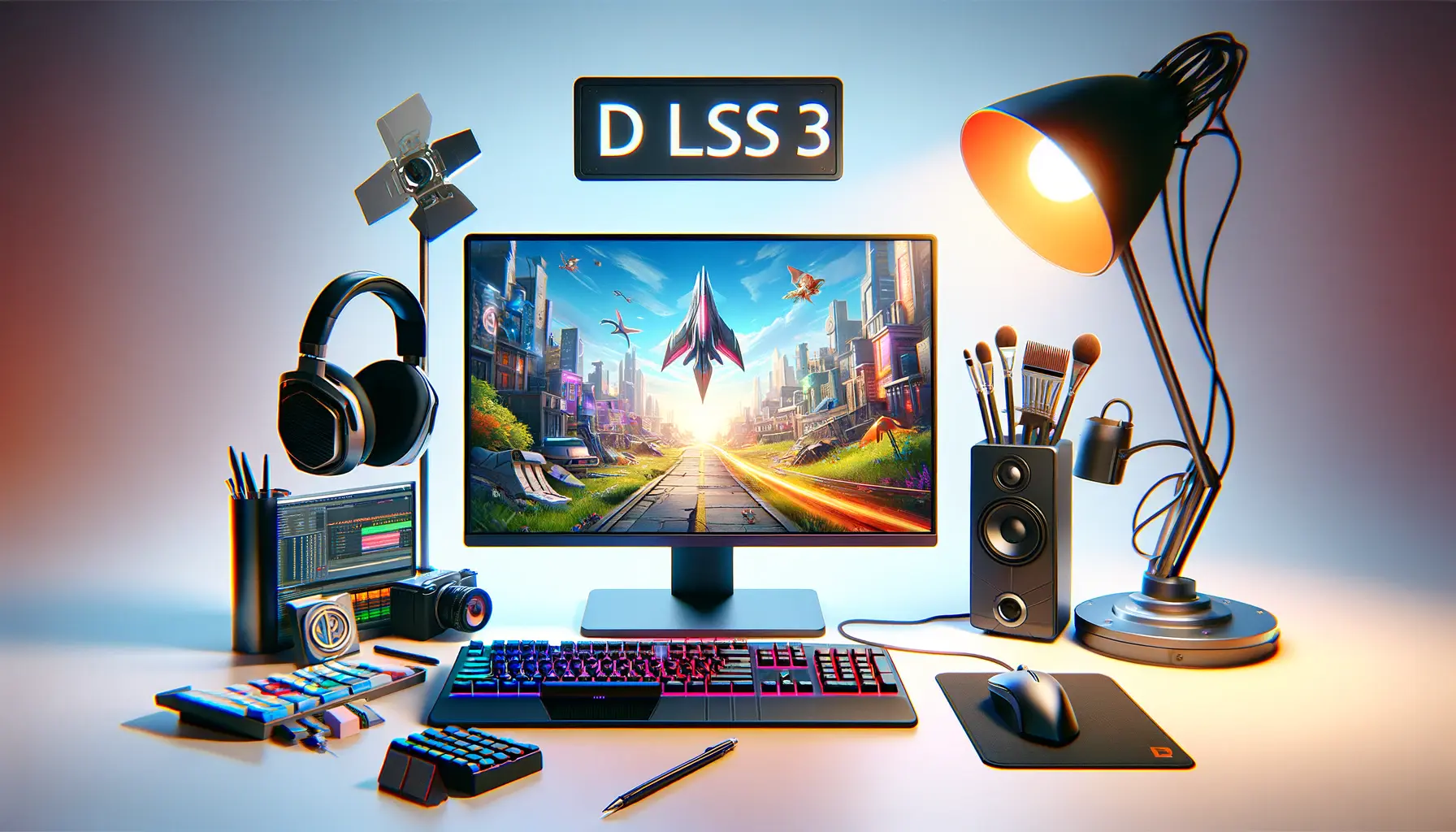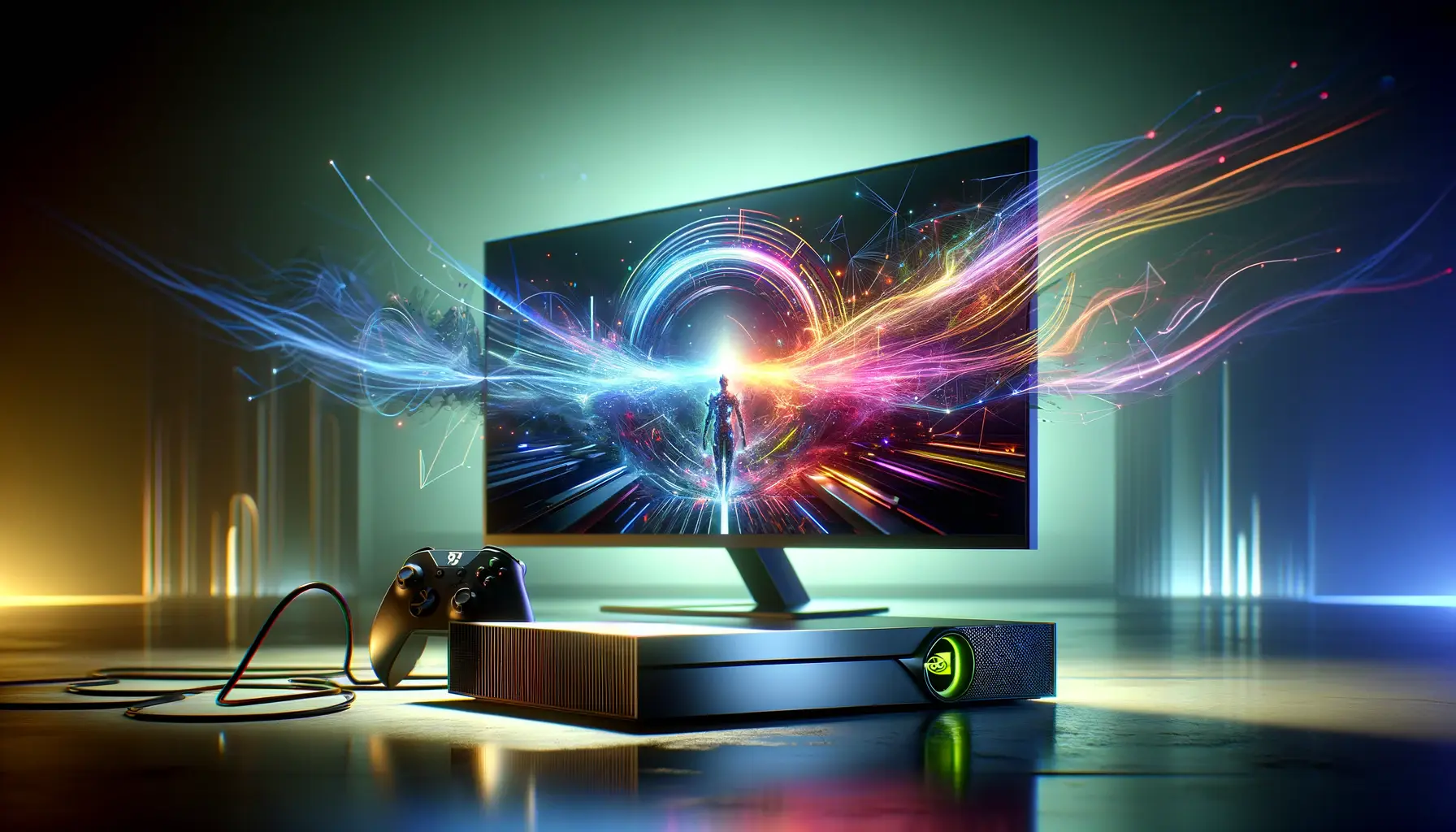The realm of 4K gaming has always been the pinnacle of visual fidelity and immersive gameplay experiences.
However, achieving smooth performance at this ultra-high resolution has often come at the cost of requiring top-tier hardware.
This is where NVIDIA’s Deep Learning Super Sampling (DLSS) technology, particularly DLSS 3, steps in to revolutionize the gaming landscape.
DLSS 3 not only promises to enhance 4K gaming but also to make it more accessible to a broader range of gamers by leveraging artificial intelligence to boost frame rates without compromising on visual quality.
DLSS 3, the latest iteration in NVIDIA’s lineup of game-changing technologies, utilizes advanced AI algorithms to interpolate frames, effectively rendering games at a lower resolution and then upscaling them to 4K.
This process significantly reduces the computational load on the GPU, allowing for higher frame rates and smoother gameplay.
The technology is a boon for gamers looking to enjoy the latest titles at the pinnacle of graphical settings without needing to invest in the most expensive hardware on the market.
- Understanding DLSS 3 and Its Impact on 4K Gaming
- How DLSS 3 Enhances Game Visuals and Performance
- DLSS 3 Compatibility and Requirements
- Future of Gaming with DLSS 3
- Challenges and Considerations for DLSS 3 Adoption
- Comparing DLSS 3 with Other Upscaling Technologies
- Optimizing Your Gaming Setup for DLSS 3
- Embracing the Future of 4K Gaming with DLSS 3
- DLSS 3 and 4K Gaming FAQs
Understanding DLSS 3 and Its Impact on 4K Gaming
What is DLSS 3?
At its core, DLSS 3 is an AI-driven rendering technology designed by NVIDIA to enhance graphics performance.
By rendering fewer pixels and using deep learning algorithms to upscale images to 4K resolution, DLSS 3 allows games to run at higher frame rates, making 4K gaming more fluid and responsive.
This technology is particularly effective in graphically intensive titles, where maintaining high frame rates is crucial for a good gaming experience.
DLSS 3’s frame generation capability is a standout feature, creating additional frames to insert between existing ones.
This not only boosts the frame rate but does so with minimal impact on input lag, a common concern with other upscaling technologies.
The result is a gaming experience that feels both smooth and responsive, even in the most demanding scenes.
The Benefits of DLSS 3 for Gamers
The introduction of DLSS 3 has been a game-changer for the gaming community, particularly for those passionate about 4K gaming.
One of the most significant benefits is the ability to enjoy the highest quality visuals without needing the absolute latest in GPU technology.
This democratizes access to premium gaming experiences, allowing more players to enjoy the latest titles at their best.
Moreover, DLSS 3 enhances game performance without the traditional trade-offs associated with upscaling technologies.
By maintaining high image quality while boosting frame rates, gamers no longer have to choose between visual fidelity and smooth performance.
This balance is crucial for immersive gaming, where every detail and every frame can contribute to the overall experience.
DLSS 3 represents a significant leap forward in making 4K gaming more accessible and enjoyable, offering a blend of performance and quality that was previously hard to achieve.
How DLSS 3 Enhances Game Visuals and Performance
DLSS 3’s innovative approach to upscaling and frame generation significantly enhances both the visuals and performance of games.
This technology is not just about increasing frame rates; it’s about doing so while preserving, and in some cases even enhancing, the visual quality of games.
By intelligently generating frames, DLSS 3 reduces the workload on the GPU, allowing for higher settings or resolutions without the performance penalty typically associated.
One of the key components of DLSS 3 is its use of AI to predict and generate frames.
This process involves:
- Analysing previous frames to predict motion and changes in the scene.
- Generating new frames based on these predictions to insert between existing ones, effectively increasing the frame rate.
- Applying anti-aliasing techniques to ensure that the upscaled images maintain high quality, with sharp details and minimal artifacts.
Case Studies: DLSS 3 in Action
Several games have already benefited from DLSS 3, showcasing its ability to transform gaming experiences.
For instance, in “Cyberpunk 2077,” a title known for its demanding graphics, DLSS 3 has enabled gamers to experience the game in 4K with ray tracing enabled, all while maintaining smoother frame rates than ever before.
Similarly, “Fortnite” has seen performance improvements, allowing for higher frame rates on 4K displays without compromising the game’s visual fidelity.
These case studies demonstrate DLSS 3’s capability to:
- Significantly boost frame rates, making games feel smoother and more responsive.
- Allow for higher graphic settings and resolutions, even on less powerful hardware.
- Improve the overall gaming experience by enhancing visual quality and performance simultaneously.
The impact of DLSS 3 extends beyond just individual gamers. It sets a new standard for developers, enabling them to create more visually stunning games without worrying about alienating players with less powerful hardware.
DLSS 3 Compatibility and Requirements
The revolutionary benefits of DLSS 3 come with specific hardware requirements, primarily because the technology leverages the unique capabilities of NVIDIA’s RTX 40-series GPUs.
These graphics cards are equipped with dedicated Tensor Cores and AI algorithms designed to run DLSS 3 efficiently, making them a prerequisite for gamers looking to take advantage of this technology.
To utilize DLSS 3, gamers need:
- An NVIDIA GeForce RTX 40-series GPU, as these cards come with the necessary hardware acceleration for DLSS 3’s AI-driven processes.
- Games that support DLSS 3, as the technology requires integration at the game development level to function.
- The latest NVIDIA drivers, ensuring that the GPU is up to date with the newest optimizations and features for DLSS 3.
Setting Up DLSS 3 for Optimal Performance
Optimizing DLSS 3 for the best balance between performance and visual quality involves adjusting game settings and NVIDIA Control Panel options.
Gamers should:
- Enable DLSS 3 within the game’s graphics settings, often found under the advanced or NVIDIA-specific options.
- Select the desired DLSS mode, such as “Quality” for higher visual fidelity or “Performance” for maximizing frame rates.
- Adjust in-game settings to balance performance and visual quality, considering the impact of DLSS 3 on overall gameplay experience.
While DLSS 3 opens up new possibilities for 4K gaming, it’s important for gamers to understand the balance between hardware capabilities and personal preferences for game settings.
The technology offers various modes to cater to different priorities, whether it’s achieving the smoothest gameplay or the sharpest image quality.
Exploring the settings and modes available within DLSS 3 can help gamers find the perfect setup for their specific gaming preferences and hardware configurations.
Future of Gaming with DLSS 3
The introduction of DLSS 3 marks a significant milestone in the evolution of gaming technology, offering a glimpse into the future of how games will be developed and experienced.
As more developers begin to integrate DLSS 3 into their titles, we can anticipate a new era where 4K gaming becomes the standard, not the exception.
This shift is expected to drive further innovations in gaming graphics, performance optimization, and AI-driven technologies.
With DLSS 3, the future of gaming looks promising, characterized by:
- Wider adoption of 4K and even 8K resolutions as standard gaming experiences, thanks to the efficiency and performance improvements offered by DLSS 3.
- Increased accessibility to high-quality gaming experiences across a broader range of hardware, reducing the need for frequent, costly upgrades.
- Enhanced creative possibilities for game developers, who can now push the boundaries of visual fidelity and complex game mechanics without being constrained by hardware limitations.
Anticipated Developments in DLSS Technology
As NVIDIA continues to refine and enhance DLSS, future versions are expected to bring even more advancements.
Potential developments could include:
- Improved AI algorithms for even more accurate frame prediction and generation, further enhancing visual quality and performance.
- Broader compatibility with a wider range of GPUs, making DLSS technology accessible to more gamers.
- Integration of DLSS with other gaming technologies, such as ray tracing, to create even more immersive and realistic gaming environments.
The ongoing evolution of DLSS technology signifies NVIDIA’s commitment to revolutionizing gaming performance and quality.
As DLSS becomes more sophisticated and widely adopted, it will continue to shape the gaming industry, setting new standards for what gamers can expect from their gaming experiences.
The future of gaming with DLSS 3 promises not only enhanced visual and performance benefits but also a shift towards more inclusive and innovative gaming experiences for all.
Challenges and Considerations for DLSS 3 Adoption
While DLSS 3 presents a significant advancement in gaming technology, its adoption is not without challenges.
These hurdles stem from both technical and market perspectives, influencing how quickly and widely DLSS 3 can become a staple in the gaming industry.
Understanding these challenges is crucial for both developers and gamers as they navigate the evolving landscape of game graphics and performance optimization.
Key challenges include:
- Hardware Requirements: DLSS 3’s reliance on RTX 40-series GPUs limits its accessibility to gamers with the latest hardware. This requirement poses a barrier to widespread adoption, particularly among gamers with older or less powerful systems.
- Game Developer Integration: Implementing DLSS 3 into games requires effort from developers, including updates and optimizations specific to the technology. This additional development work may slow the rate at which games adopt DLSS 3.
- Consumer Awareness and Understanding: Educating gamers about the benefits and workings of DLSS 3 is essential for its adoption. Misunderstandings or lack of awareness about the technology could hinder its acceptance among the gaming community.
Strategies for Overcoming DLSS 3 Adoption Barriers
To address these challenges and encourage the adoption of DLSS 3, several strategies can be employed:
- Enhancing Hardware Accessibility: Introducing DLSS 3 support in a wider range of NVIDIA GPUs, including future mid-range models, could make the technology accessible to a broader audience.
- Developer Support and Incentives: NVIDIA could offer tools, documentation, and support to ease the integration process for game developers, possibly including incentives for early adoption of DLSS 3.
- Comprehensive Education Campaigns: Engaging marketing and educational campaigns can help demystify DLSS 3 for gamers, showcasing its benefits and how it enhances the gaming experience.
Overcoming the challenges associated with DLSS 3 adoption will require concerted efforts from NVIDIA, game developers, and the gaming community.
By addressing these hurdles, DLSS 3 has the potential to redefine gaming performance and visual quality, setting a new standard for the industry.
Despite the challenges, the potential benefits of DLSS 3 for enhancing gaming experiences are undeniable, paving the way for its eventual widespread adoption.
Comparing DLSS 3 with Other Upscaling Technologies
As DLSS 3 emerges as a groundbreaking technology for enhancing gaming performance and visual quality, it’s important to understand how it stacks up against other upscaling technologies.
The gaming industry has seen various approaches to upscaling, each with its own set of advantages and limitations.
Comparing DLSS 3 with these technologies provides insight into its unique value proposition and potential impact on the future of gaming.
Key comparisons include:
- Traditional Upscaling: Traditional upscaling methods, such as bilinear or bicubic interpolation, simply stretch lower-resolution images to fit a higher-resolution display. While this process can make games playable at higher resolutions, it often results in blurry textures and a noticeable loss of detail. DLSS 3, with its AI-driven approach, not only upscales images but also enhances them, maintaining sharpness and detail that traditional methods cannot match.
- AMD FidelityFX Super Resolution (FSR): AMD’s FSR is another upscaling technology designed to improve frame rates and image quality. While FSR is compatible with a wide range of GPUs, including those from NVIDIA, it relies on spatial upscaling techniques rather than AI. This means that while FSR can offer performance improvements, it may not achieve the same level of image quality enhancement as DLSS 3’s AI-based frame generation and upscaling.
- Temporal Anti-Aliasing (TAA): TAA is a common technique used to reduce aliasing (the jagged edges of objects) in games. While TAA can improve image smoothness, it sometimes introduces motion blur and does not inherently boost frame rates. DLSS 3, on the other hand, addresses both aliasing and performance, offering a more comprehensive solution for enhancing game visuals and smoothness.
The Unique Advantages of DLSS 3
DLSS 3 stands out from other upscaling technologies due to its innovative use of AI to generate new frames, a feature that goes beyond simple upscaling.
This capability allows DLSS 3 to:
- Significantly boost frame rates without compromising image quality, making 4K gaming more accessible and enjoyable.
- Reduce the performance impact of enabling high-quality graphics settings and ray tracing, allowing gamers to experience the full visual potential of their games.
- Adapt dynamically to different types of game content, ensuring optimal performance and visual quality across a wide range of gaming scenarios.
By comparing DLSS 3 with other upscaling technologies, it becomes clear that DLSS 3 offers a unique blend of performance enhancement and image quality improvement.
Its AI-driven approach sets a new benchmark for what gamers can expect from upscaling technologies, promising a future where high-resolution, high-fidelity gaming is more accessible than ever.
While other upscaling technologies offer valuable benefits, none currently match DLSS 3’s ability to enhance both performance and visual quality to the same extent.
Optimizing Your Gaming Setup for DLSS 3
To fully harness the power of DLSS 3 and elevate your 4K gaming experience, optimizing your gaming setup is essential.
This goes beyond just having the right hardware; it involves fine-tuning your system settings, choosing the right components, and understanding how to leverage DLSS 3 effectively in your favorite games.
By taking these steps, gamers can ensure they are getting the most out of this innovative technology.
Key strategies for optimizing your gaming setup for DLSS 3 include:
- Choosing the Right Display: To experience the full benefits of DLSS 3, a high-resolution display is crucial. Opt for a monitor that supports 4K resolution with a high refresh rate to enjoy smooth and sharp visuals.
- System Configuration: Ensure your PC’s other components, such as the CPU and RAM, are not bottlenecks. DLSS 3 can significantly boost GPU performance, but a balanced system is key to achieving the best overall gaming experience.
- Game Settings: Experiment with the in-game DLSS settings to find the perfect balance between performance and image quality. Each game may offer different DLSS modes, such as “Quality,” “Balanced,” and “Performance,” allowing you to tailor the gaming experience to your preferences.
Maximizing DLSS 3 Benefits
To maximize the benefits of DLSS 3, gamers should also:
- Stay updated with the latest GPU drivers from NVIDIA. These updates often include optimizations for new games and improvements to DLSS technology.
- Monitor in-game performance using tools like NVIDIA GeForce Experience. This can help you see the impact of DLSS 3 on frame rates and adjust settings accordingly.
- Engage with the gaming community to share tips and learn from others’ experiences with DLSS 3. Community forums and social media can be great resources for discovering optimization tricks and game-specific advice.
Optimizing your gaming setup for DLSS 3 not only enhances your current gaming experiences but also future-proofs your system for upcoming titles.
As more games adopt DLSS 3, taking the time to fine-tune your setup ensures you’ll be ready to enjoy the next generation of gaming visuals and performance.
Embracing DLSS 3 technology and optimizing your gaming setup accordingly can transform your gaming experience, offering a glimpse into the future of high-performance, high-fidelity gaming.
Embracing the Future of 4K Gaming with DLSS 3
The journey through the intricacies of DLSS 3 and its transformative impact on 4K gaming culminates in a future where ultra-high-resolution gaming is not just a luxury, but a standard.
DLSS 3, with its AI-driven approach to enhancing performance and visual fidelity, stands at the forefront of this revolution, offering gamers and developers alike a glimpse into the potential of next-generation gaming experiences.
The Path Forward with DLSS 3
As we look towards the horizon, the adoption of DLSS 3 across the gaming industry signifies more than just technological advancement; it represents a shift in the gaming paradigm.
Gamers equipped with DLSS 3 can now enjoy the zenith of gaming visuals without the traditional barriers of hardware limitations, setting a new benchmark for what is considered premium gaming experiences.
- DLSS 3 democratizes 4K gaming, making it accessible to a wider audience by optimizing performance without compromising on quality.
- The technology encourages innovation among game developers, who can now push the boundaries of graphical fidelity and complex game mechanics.
- As DLSS 3 continues to evolve, we can anticipate even greater enhancements in AI algorithms, further improving frame generation and upscaling techniques.
Charting the Course for Gamers and Developers
The widespread implementation of DLSS 3 will undoubtedly shape the future development of games, influencing both the creative and technical aspects of game design.
For gamers, staying informed about the latest advancements in DLSS technology and optimizing their setups will be key to unlocking the full potential of their gaming experiences.
- Regularly updating hardware drivers and engaging with the gaming community will help gamers stay ahead of the curve, ensuring they can make the most of DLSS 3’s capabilities.
- Developers are encouraged to integrate DLSS 3 into their titles, leveraging NVIDIA’s support and resources to enhance game performance and visual quality.
- The collaboration between NVIDIA, game developers, and the gaming community will be instrumental in driving the future success and innovation of DLSS 3 technology.
In conclusion, DLSS 3 not only enhances 4K gaming today but also lays the foundation for the future of gaming.
Its ability to balance performance with unparalleled visual quality represents a significant leap forward, promising a new era where immersive, high-fidelity gaming experiences are universally accessible.
As we embrace DLSS 3 and its capabilities, the gaming world stands on the brink of an exciting new chapter, filled with possibilities limited only by the imagination.
DLSS 3 and 4K Gaming FAQs
Explore common questions about enhancing your 4K gaming experience with DLSS 3.
DLSS 3 is NVIDIA’s AI-driven technology that boosts frame rates in games by generating additional frames, enhancing both performance and image quality at 4K resolution.
By rendering fewer pixels and using AI to upscale images, DLSS 3 significantly increases frame rates without compromising visual fidelity, making 4K gaming smoother.
No, DLSS 3 requires NVIDIA GeForce RTX 40-series GPUs, as it leverages specific hardware capabilities of these cards to perform its AI-driven processes.
DLSS 3 offers three modes: Quality, Balanced, and Performance, allowing gamers to choose the optimal balance between image quality and frame rate.
No, games must be specifically developed or updated to support DLSS 3. The list of compatible games is continuously growing as more developers adopt the technology.
To enable DLSS 3, go to the game’s graphics settings and select DLSS 3 under the resolution or graphics quality options, depending on the game.
DLSS 3 can add minimal latency, but NVIDIA’s Reflex technology is integrated to mitigate this, ensuring responsive gameplay even with DLSS 3 enabled.
The primary limitation of DLSS 3 is its requirement for RTX 40-series GPUs, making it inaccessible to gamers without the latest hardware.














